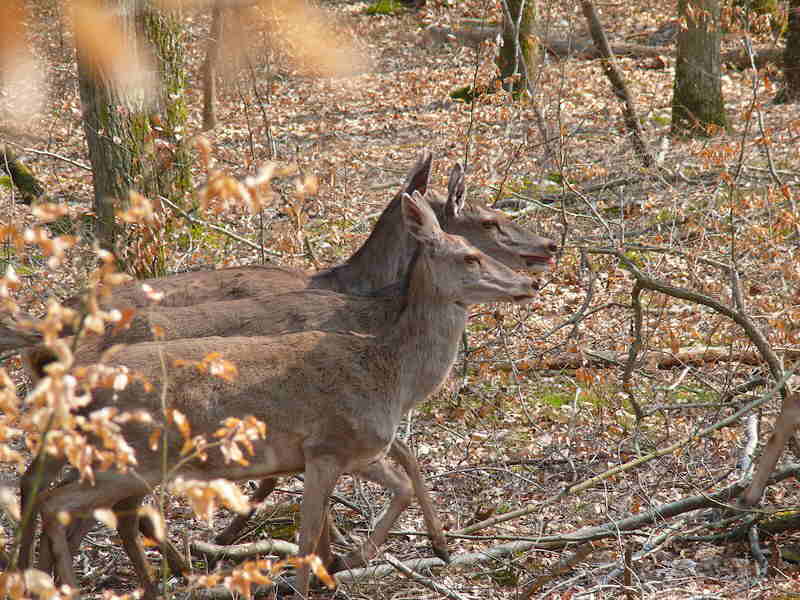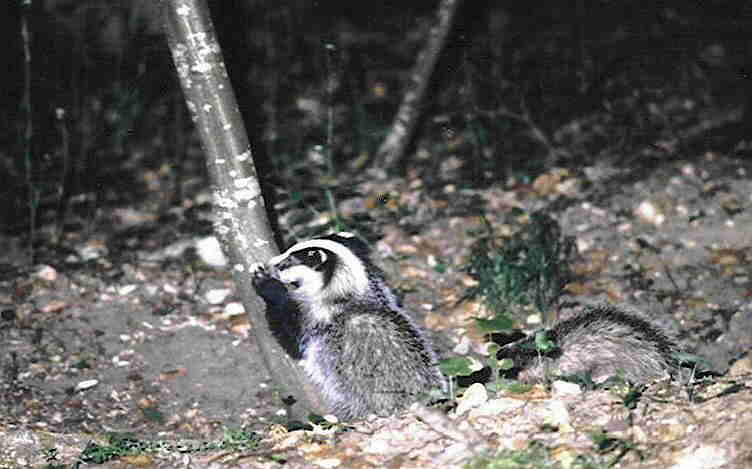ZOOLOGY IN THE FOREST OF FONTAINEBLEAU PRESENTED BY BIOTOPES

The great variety of biotopes (different environmental areas) yields a remarkable biodiversity especially regarding the wildlife. We will thus describe the different characteristic biotopes and the wildlife you can encounter in each of them.
- The high forest of hardwood and resinous trees:
This is the favourite domain of great and small mammals: Deers, boars are at home but the roes prefer the edges of that forest, either the borders, or the clearings. Foxes, badgers, and the rare marten live under the high trees. The bats hunt under the trees along the forest borders, the clearings, the trails and forest roads. Numerous bird species colonize all layers of the hardwood. Some raptors eat the small rodents living on the soil like rats and shrews: sparrowhawks, buzzards and nocturnal raptors. The Black Pic is present everywhere in the whole Forest.
Some birds prefer the resinous trees : the crested wrens, the black and the crested tits, the spouts. Among the raptors, the middle-duke owl, the sparrowhawk and the rare goshawk behave this way.
Among the nocturnal bats, the noctule of Leisler, the serotine and the pipistrelle hunt between the pines.
Under the high trees, the lizards and the grass-snake like to take the sun heat on the edges of the forest paths. Other small animals (the slow worm, the red frog, the agile frog, the common toad) seek shadows and wetness: they prefer to hide under the leaves. The rare viper snake hunts small animals under the shadow of oaks. Only the pipistrelle is able to hunt between the tree branches.
- The very old hardwood areas with oaks and beeches:
Fontainebleau has some “integral reserve” areas where no wood cutting has been done since centuries. Five-hundred years old oaks grow there beneath 300 years old beeches. Those trees are rich in holes with many inhabitants: black pic, mar pic, ashed pic, columbine pigeon, chickadee, tawny owl. Those areas are forbidden to hikers and thus very calm, the best hiding site for boars or cervid herds. But the paucity of light yields few vegetation, leading the cervids to quit those areas for eating. For the same reason, snakes are rare in reserve areas, except slow worms, and palmed tritons in the few ponds. The trees being somehow packed he bats do not hunt much there, lacking space to fly, although they may habit the holes in the old trees. You can however sometimes observe murine bats hunting at the integral reserve borders. The exceptional old tree reserves of Fontainebleau deserve a visit, the most beautiful being the Gros Fouteau, the Tillaie, the Gorge aux Loups, the Gorge aux merisiers and near the Solle horse racecourse.
- The regenerating plots of wood :
After a cutting, the first stage of regeneration is the most interesting : in fact this is the favourite home for spotted locustelle, linnets with beautiful songs, wheatear, shrikes. Hares and rabbits are chased by foxes. The bats come to hunt insects, and the raptors like hawks, buzzards and honey buzzards hunt small mammals. You may find on the sunny places lizards and grass-snakes seeking the warmth. Some bird species like the open spaces: the buntings, the larks, the pheasants, the blackbirds. Bats do like the pine regeneration areas and 6 species come here to hunt, mainly noctules and serotines, sometimes murine bats. Boars and cervid herds like to find good shelters in the regeneration thickets.
- The platières and their temporary ponds :
Those are flat sand and sandstone areas where a studded vegetation (heather, pines and birches) develops due to the unfertile soil. In the troughs the rain accumulates mare, yielding ponds. Some birds like that environment : larks, loggerheads, nightjars, warblers, pipits, wheatears, torcols, hoopooes. All the diurnal raptor species come here to hunt, the most abundant being the buzzards. Snakes abund: grass-snakes, lizards.
In the ponds you find green frogs, tritons, and in the warm summer nights you may hear the toads. They lay their eggs only if the ponds are sufficiently deep to keep water until the youngs are developed. The mammals use rarely those sites except some deers. The bats too come rarely except some noctules. The most characteristic of the platières are the plaines de la haute Borne, the rocher de la Reine and Franchard.
- The permanent ponds:
They are rare in the Fontainebleau Forest, due to the permeable sand in the soil. However, in the North, the soil is quite impermeable and wet areas exist with permanent ponds. The great mammals like to come here to bath (deers, boars). A great variety of bats (9 species) live there; ducks and coots too. There are kingfishers and herons, the latters spending often their nights there. Toads, tritons, frogs abund as well as grass-snakes. The most interesting ponds are in the Evées and the Boissière areas.
The Forest borders
 Near the Seine river the bats find much to hunt and 6 species are encountered, mainly the murine bats. Many birds live there or come in winter when their ponds are iced: kingfishers, grebes, bruants, and rarely mergansers and golden-eye garrots. The cervids find there abundant feeding and water. The raptor birds are also frequently observed, especially buzzards, owls, hawks. Foxes and weasels find plenty of small mammals to hunt. Toads are frequently heard at night in summer. Sometimes snakes like grass-snake, viper, lizards or smooth snake may be encountered in the sunny places but they are very fearful and hide at the least alarm.
Near the Seine river the bats find much to hunt and 6 species are encountered, mainly the murine bats. Many birds live there or come in winter when their ponds are iced: kingfishers, grebes, bruants, and rarely mergansers and golden-eye garrots. The cervids find there abundant feeding and water. The raptor birds are also frequently observed, especially buzzards, owls, hawks. Foxes and weasels find plenty of small mammals to hunt. Toads are frequently heard at night in summer. Sometimes snakes like grass-snake, viper, lizards or smooth snake may be encountered in the sunny places but they are very fearful and hide at the least alarm.
Near the towns in the Forest borders and in the gardens are numerous animals: 8 species of bats ( especially the serotine and the pipistrelle), the weasel and the fox; all species of pic like to fly around the towns.
